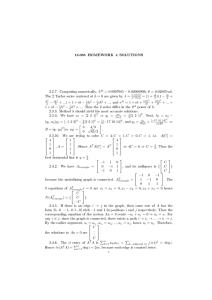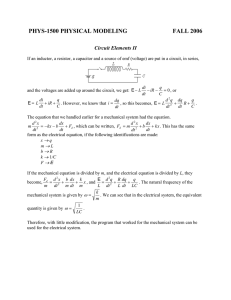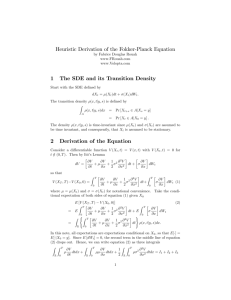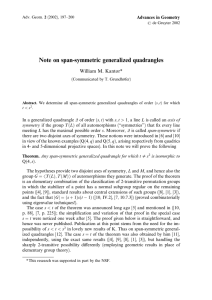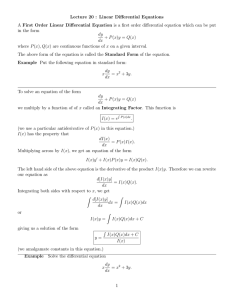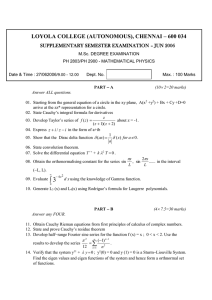CHAPTER 77 SOLUTION OF FIRST ORDER DIFFERENTIAL
advertisement
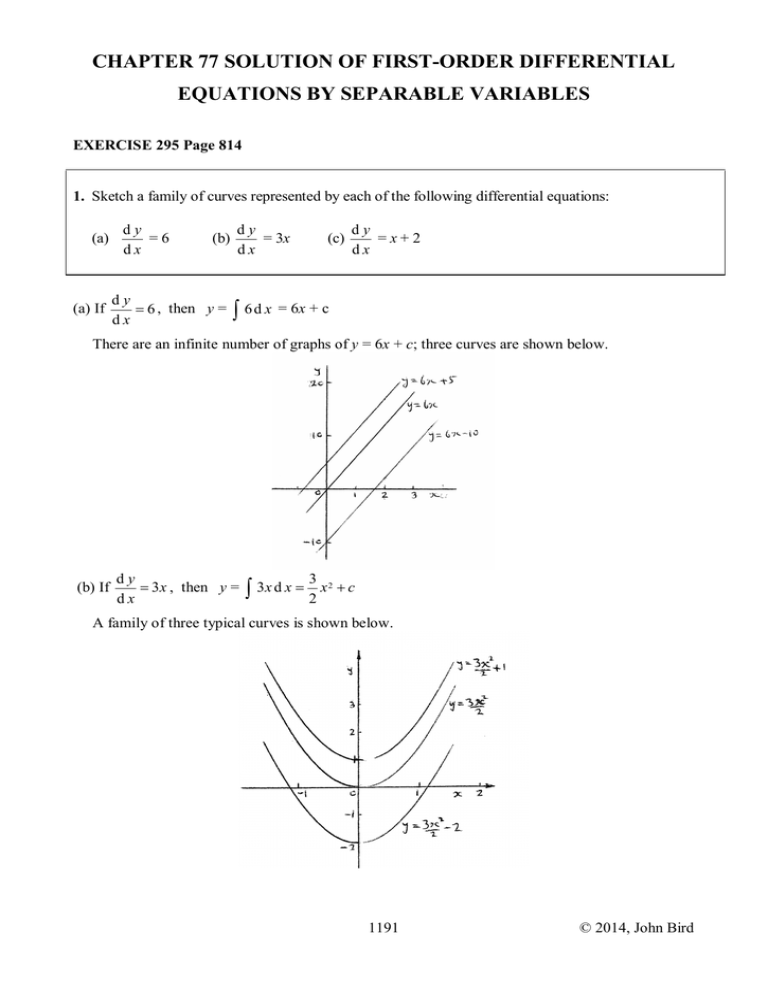
CHAPTER 77 SOLUTION OF FIRST-ORDER DIFFERENTIAL EQUATIONS BY SEPARABLE VARIABLES EXERCISE 295 Page 814 1. Sketch a family of curves represented by each of the following differential equations: (a) (a) If dy =6 dx (b) dy = 6 , then y = dx dy = 3x dx (c) dy =x+2 dx ∫ 6 d x = 6x + c There are an infinite number of graphs of y = 6x + c; three curves are shown below. (b) If dy = 3 x , then y = dx dx ∫ 3x= 3 2 x +c 2 A family of three typical curves is shown below. 1191 © 2014, John Bird (c) If dy = x + 2 , then y = dx ∫ ( x + 2) d x = x2 + 2x + c 2 A family of three typical curves is shown below. 2. Sketch the family of curves given by the equation dy = 2x + 3 and determine the equation of one of dx these curves which passes through the point (1, 3). If dy = 2 x + 3 , then y = dx ∫ ( 2 x + 3) d x = x 2 + 3x + c If the curve passes through the point (1, 3) then x = 1 and y = 3 Hence, and 3 = (1) + 3 (1) + c 2 i.e. c = –1 y = x 2 + 3x − 1 A family of three curves is shown below, including y = x 2 + 3 x − 1 , which passes through the point (1, 3) 1192 © 2014, John Bird EXERCISE 296 Page 816 dy = cos 4x – 2x dx 1. Solve: Since dy = cos 4x – 2x dx i.e. y= 2. Solve: 2x Since 2x 1 sin 4 x − x 2 + c 4 dy = 3 – x3 dx dy = 3 – x3 dx i.e. d y 3 − x3 3 x3 3 x2 = = − = − dx 2x 2x 2x 2x 2 3 x3 3 x2 +c y = ∫ − d x = ln x – 2 6 2x 2 Hence, 3. Solve: If ∫ ( cos 4 x − 2 x ) d x y= dy + x = 3, given y = 2 when x = 1 dx dy dy 3 , then +x= = 3− x dx dx and y = If y = 2 when x = 1, then 2 = 3 – y = 3x − Hence, 4. Solve: 3 Since 3 and 1 +c 2 ∫ ( 3 − x ) d x = 3x − from which, x2 +c 2 c= − 1 2 x2 1 − 2 2 π dy 2 + sin θ = 0, given y = when θ = 3 dθ 3 dy + sin θ = 0 dθ i.e. dy 1 = – sin θ dθ 3 1 1 1 y = ∫ − sin θ d θ = − (− cos θ ) + c = cos θ + c 3 3 3 1193 © 2014, John Bird y= 2 π when θ = 3 3 2 1 π hence, = cos + c 3 3 3 2 11 = +c 3 3 2 i.e. = y Hence, 5. Solve: If 2 11 i.e. − = c 3 3 2 i.e. 1 2 1 1 cos θ + 3 2 1 dy +2=x–3 , given y = 1 when x = 0 ex dx 1 dy + 2 = x −3 ex dx then 3 If y = 1 when x = 0, then Thus, dy =x − e − x − 2 dx y= 1= 1 (0 + 1 + 0) + c 3 1 x2 2 −x + e − 2x + 3 2 3 6. The gradient of a curve is given by the point (1, and dy 1 = ( x − e− x − 2 ) dx 3 1 1 x2 − x − 2 dx −x − = x e ( ) + e − 2x + c ∫ 3 3 2 y= Hence, If c= or i.e. c= 2 3 1 2 2 x − 4x + x + 4 6 e dy x2 + = 3x. Find the equation of the curve if it passes through dx 2 1 ). 3 dy d y x2 x2 3 x , then + = = 3x − dx 2 dx 2 Hence, y= ∫ 3x − x2 3x 2 x3 − +c d x = 2 2 6 1 1 If it passes through 1, , x = 1 and y = 3 3 Thus, Hence, 1 3 1 = − +c 3 2 6 y= from which, c= 1 3 1 − + = −1 3 2 6 3 2 x3 x − −1 2 6 1194 © 2014, John Bird 7. The acceleration a of a body is equal to its rate of change of velocity, dv . Find an equation for v in dt terms of t, given that when t = 0, velocity v = u. dv =a dt v = ∫ a d= t at + c hence, When t = 0, velocity v = u, hence, Hence, u=0+c from which, c = u velocity, v = at + u or v = u + at 8. An object is thrown vertically upwards with an initial velocity u of 20 m/s. The motion of the object follows the differential equation ds = u – gt, where s is the height of the object in metres at time t dt seconds and g = 9.8 m/s2. Determine the height of the object after 3 seconds if s = 0 when t = 0 If ds = u – gt, then dt s= ∫ ( u − gt ) d t =ut − g t2 +c 2 Since s = 0 when t = 0, then c = 0 Hence, = s ut − g t2 and if u = 20 and s = 9.8, then 2 The height when t = 3, i.e. s = 3(20) – 4.9 ( 3) s = 20t – 9.8t 2 2 i.e. u = 20t – 4.9 t 2 2 height = 60 – 44.1 = 15.9 m 1195 © 2014, John Bird EXERCISE 297 Page 817 1. Solve: dy = 2 + 3y dx Rearranging dy dy = 2 + 3y gives: dx = 2 + 3y dx dy ∫ d x = ∫ 2 + 3y Integrating both sides gives: Thus, by using the substitution u = (2 + 3y), x= 2. Solve: If dy = 2 cos2 y dx dy = 2 cos 2 y then dx dy = 2d x cos 2 y ∫ sec and i.e. 2 y d y = ∫ 2d x tan y = 2x + c 3. Solve: (y2 + 2) If 1 ln(2 + 3y) + c 3 ( y2 + 2) dy 1 = 5y, given y = 1 when x = dx 2 dy then 5y = dx y2 + 2 ln y = 5x + c 2 i.e. and 2 ∫ y + y d y = ∫ 5d x and y = 1 when x = y2 + 2 d y = 5d x y 1 , hence, 2 1 5 + 2 ln1 =+ c 2 2 from which, c= 1 5 − = −2 2 2 y2 + 2 ln y = 5x − 2 2 1196 © 2014, John Bird 4. The current in an electric circuit is given by the equation Ri + L di = 0, where L and R are constants. dt Show that i = Ie–Rt/L, given that i = I when t = 0 If Ri + L di di = 0, then L = –Ri dt dt and di Ri = − dt L from which, di R = − dt i L Thus, ln i = − i = I when t = 0, thus ln I = c Hence, ln i = − i.e. ln i – ln I = − i.e. ln ∫ and di = i R ∫ − L dt Rt +c L Rt + ln I L Rt L i Rt = − I L Taking anti-logarithms gives: Rt i − =e L I and 5. The velocity of a chemical reaction is given by i=Ie − Rt L dx = k(a – x), where x is the amount transferred in dt time t, k is a constant and a is the concentration at time t = 0 when x = 0. Solve the equation and determine x in terms of t. If dx = k(a – x), then dt dx = k dt a−x dx and ∫ a − x = ∫ k dt i.e. – ln(a – x) = kt + c t = 0 when x = 0, hence Thus, – ln a = c – ln(a – x) = kt – ln a 1197 © 2014, John Bird i.e. ln a – ln(a – x) = kt i.e. a ln = kt a−x and a = e kt a−x i.e. a = a−x ek t and x = a – a e− k t i.e. i.e. a e − k t= a − x = x a (1 − e − k t ) 6. (a) Charge Q coulombs at time t seconds is given by the differential equation R dQ Q + = 0, where dt C C is the capacitance in farads and R the resistance in ohms. Solve the equation for Q given that Q = Q 0 when t = 0 (b) A circuit possesses a resistance of 250 × 103 ohms and a capacitance of 8.5 × 10–6 farads, and after 0.32 seconds the charge falls to 8.0 C. Determine the initial charge and the charge after 1 second, each correct to 3 significant figures. (a) If R dQ Q =0 + dt C i.e. i.e. dQ Q = − dt RC then ∫ dQ = Q 1 ∫ − RC d t ln Q = − t +k RC Q = Q 0 when t = 0, hence, ln Q 0 = k Hence, i.e. i.e. and ln Q = − t + ln Q0 RC ln Q – ln Q 0 = − ln t RC Q t = − Q0 RC t − Q = e RC Q0 and Q = Q0 e − t CR (b) R = 250 × 103 Ω , C = 8.5 × 10–6 F, t = 0.32 s and Q = 8.0 C 1198 © 2014, John Bird 0.32 −6 3 Hence, = 8.0 Q= Q0 ( 0.8602 ) 0 e 8.5×10 ×250×10 − 8.0 = 9.30 C 0.8602 from which, initial charge, Q 0 = When t = 1 s, charge, Q = Q0 e − t CR = 9.30 e − 1 8.5×10−6 ×250×103 = 5.81 C 7. A differential equation relating the difference in tension T, pulley contact angle θ and coefficient of friction µ is dT = µT. When θ = 0, T = 150 N, and µ = 0.30 as slipping starts. Determine the tension dθ at the point of slipping when θ = 2 radians. Determine also the value of θ when T is 300 N. Since dT dT = µT then = µ dθ dθ T dT = ∫ µ dθ T and ∫ i.e. ln T = μθ + c When θ = 0, T = 150 N, and µ = 0.30, hence ln 150 = (0.30)(0) + c from which, c = ln 150 Hence, ln T = μθ + ln 150 i.e. ln T – ln 150 = μθ i.e. T ln = µθ 150 from which, T = e µθ 150 and T = 150 e µθ When θ = 2 radians, tension, T = 150 e( 0.30)(2) = 150 e0.60 = 273.3 N When T = 300 N, Hence, 300 = 150 e(0.30)θ i.e. 300 (0.30)θ =e 150 i.e. 2 = e(0.30)θ ln 2 = ln [e(0.30)θ ] = 0.30 θ from which, contact angle, θ = 1 ln 2 = 2.31 rad 0.30 1199 © 2014, John Bird 8. The rate of cooling of a body is given by dθ = k θ , where k is a constant. If θ = 60°C when t = 2 dt minutes and θ = 50°C when t = 5 minutes, determine the time taken for θ to fall to 40°C, correct to the nearest second. If dθ = kθ dt then dθ θ = k dt and ∫ dθ θ = ∫ k dt ln θ = kt + c i.e. When θ = 60°C, t = 2, i.e. ln 60 = 2k + c (1) When θ = 50°C, t = 5, i.e. ln 50 = 5k + c (2) (1) – (2) gives: ln 60 – ln 50 = –3k from which, 1 60 k = − ln = −0.06077 3 50 Substituting in (1): ln 60 = 2(–0.06077) + c from which, Hence, When θ = 40°C, and c = ln 60 + 2(0.06077) = 4.2159 ln θ = kt + c = –0.06077t + 4.2159 ln 40 = –0.06077t + 4.2159 time, t = 4.2159 − ln 40 = 8.672 min = 8 min 40 s 0.06077 1200 © 2014, John Bird EXERCISE 298 Page 820 1. Solve: Since dy = 2y cos x dx dy = 2 cos x d x y dy = 2y cos x then dx dy = 2 cos x d x y ∫ and ∫ i.e. ln y = 2 sin x + c 2. Solve: (2y – 1) dy If (2y – 1) = dx dy = (3x2 + 1), given x = 1 when y = 2 dx ( 3x 2 + 1) , then ∫ ( 2 y − 1) d y = ∫ ( 3x 2 + 1) d x i.e. y 2 − y = x3 + x + c x =1 when y = 2, hence, 4–2=1+1+c Thus, y 2 − y = x3 + x 3. Solve: from which, c=0 dy = e2x–y, given x = 0 when y = 0 dx dy = e2x–y = (e2x)(e– y), by the laws of indices dx Separating the variables gives: dy = e2x dx i.e. e y dy = e2x dx y − e Integrating both sides gives: ∫e Thus the general solution is: When x = 0, y = 0, thus: y d y = ∫ e2 x d x ey = 1 2x e +c 2 e0 = 1 0 e +c 2 1201 © 2014, John Bird from which, 1 1 = 2 2 c=1– Hence the particular solution is: 1 2x 1 e + 2 2 dy = 0, given x = 1 when y = 1 dx 4. Solve: 2y(1 – x) + x(1 + y) If 2y(1 – x) + x(1 + y) ey = dy =0 dx then x(1 + y) dy = –2y(1 – x) = 2y(x – 1) dx Thus, ∫ 1+ y 2( x − 1) d y = ∫ d x x y i.e. ∫ 1 2 + 1 d y = ∫ 2 − d x x y ln y + y = 2x – 2 ln x + c x = 1 when y = 1, hence, ln 1 + 1 = 2 – 2 ln 1 + c Thus, ln y + y = 2x – 2 ln x – 1 or ln y + 2 ln x = 2x – y – 1 i.e. ln y + ln x 2 = 2x – y – 1 and ln ( x 2 y ) = 2 x − y − 1 5. Show that the solution of the equation Since i.e. i.e. y2 +1 y d y then = x2 + 1 x d x ∫ y2 +1 ydy = is of the form x2 + 1 x dx from which, c = –1 y2 +1 2 = constant x +1 y x dy=∫ dx y2 +1 x2 + 1 1 1 ln ( y 2 = + 1) ln ( x 2 + 1) + c 2 2 1 1 2 + 1 2 − ln x 2 + 1 2 = ln y ( ) ( ) c 1 i.e. y2 +1 2 ln =c x2 + 1 1202 © 2014, John Bird y2 +1 ln =c x2 + 1 or y2 +1 c 2 = e = a constant 1 x + and 6. Solve xy = (1 – x2) Since xy = (1 – x2) dy for y, given x = 0 when y = 1 dx dy dx then dy x = dx y (1 − x 2 ) and i.e. xy dy = (1 − x 2 ) dx ∫ dy x = ∫ d x y 1 − x2 du x For ∫ d x let u = (1 – x2) from which, = −2 x dx 1 − x2 and dx = du −2 x 1 1 1 1 x x du = − ∫ du = − ln u = − ln (1 − x 2 ) dx= Hence, ∫ ∫ 2 u 2 2 1 − x2 u −2 x dy x = ∫ d x y 1 − x2 i.e. if ∫ then ln y = – x = 0 when y = 1, hence, ln 1 = – 1 ln(1 – x2) + c 2 1 ln 1 + c 2 from which, c = 0 1 ln(1 – x2) 2 Hence the particular solution is: ln y = – and ln y = ln (1 − x 2 ) i.e. y = (1 − x 2 ) i.e. y= − − 1 2 1 2 1 = 1 (1 − x 2 ) 2 1 (1 − x 2 ) 1203 © 2014, John Bird 7. Determine the equation of the curve which satisfies the equation xy dy = x2 – 1, and which passes dx through the point (1, 2). dy Since xy = x 2 − 1 then dx ∫ y= dy ∫ x2 −1 = dx x ∫ 1 x − d x x y 2 x2 = − ln x + c 2 2 i.e. If the curve passes through (1, 2) then x = 1 and y = 2 hence, 22 12 = − ln1 + c 2 2 Thus, y 2 x2 3 = − ln x + 2 2 2 or y2 = x 2 − 2 ln x + 3 from which, c = 3 2 8. The p.d., V, between the plates of a capacitor C charged by a steady voltage E through a resistor R is given by the equation CR dV +V=E dt (a) Solve the equation for V given that at t = 0, V = 0 (b) Calculate V, correct to 3 significant figures, when E = 25 volts, C = 20 × 10–6 farads, R = 200 × 103 ohms and t = 3.0 seconds. (a) Since CR dV +V = E then dt dV E −V = dt CR ∫ dV dt =∫ E −V CR i.e. − ln ( E − V ) = from which, At t = 0, V = 0, hence, Thus, t +k CR – ln E = k − ln ( E − V ) = t − ln E CR t ln E − ln ( E − V ) = CR 1204 © 2014, John Bird E ln E −V and t = CR t E C =e R E −V i.e. E i.e. e = E −V t CR E V =− E and =− E Ee t − t CR e CR t − = V E 1 − e C R volts i.e. t 3.0 − − (b) Voltage, V = E 1 − e C R = 25 1 − e 20×10−6 ×200×103 9. Determine the value of p, given that x3 Since x 3 dy =p–x dx then = ∫ dy dy = p − x , and that y = 0 when x = 2 and when x = 6 dx p−x dx = x3 ∫ 25 (1 − e −0.75 ) = 13.2 V = ∫ ( px ∫ p 1 3 − 2 d x x x − x −2 ) d x i.e. = ∫ dy i.e. y= i.e. − y= p 1 + +c 2x2 x y = 0 when x = 2, hence, 0= − p 1 + +c 8 2 (1) y = 0 when x = 6, hence, 0= − p 1 + +c 72 6 (2) (1) – (2) gives: 1 1 1 1 0= −p − + − 8 72 2 6 i.e. 0= − i.e. p 1 from which, p = 3 = 9 3 −3 px −2 x −1 − +c −2 −1 p 1 + 9 3 1205 © 2014, John Bird
